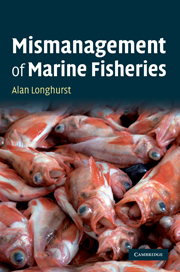Book contents
- Frontmatter
- Contents
- Preface
- 1 From certainty to doubt in fishery science
- 2 The ecological consequences of the exceptional fecundity of teleosts
- 3 Indeterminate growth, negative senescence and longevity
- 4 Marine ecosystems: their structure and simulation
- 5 The natural variability of fish populations and fisheries
- 6 Has sustainability in fishing ever been achieved?
- 7 What is the real state of global fish populations?
- 8 The mechanics of population collapse
- 9 Why don't some fish populations recover after depletion?
- 10 Is the response of the fishery science community appropriate?
- 11 Conclusion: sustainability can be achieved rarely and only under special conditions
- Index
7 - What is the real state of global fish populations?
Published online by Cambridge University Press: 05 July 2014
- Frontmatter
- Contents
- Preface
- 1 From certainty to doubt in fishery science
- 2 The ecological consequences of the exceptional fecundity of teleosts
- 3 Indeterminate growth, negative senescence and longevity
- 4 Marine ecosystems: their structure and simulation
- 5 The natural variability of fish populations and fisheries
- 6 Has sustainability in fishing ever been achieved?
- 7 What is the real state of global fish populations?
- 8 The mechanics of population collapse
- 9 Why don't some fish populations recover after depletion?
- 10 Is the response of the fishery science community appropriate?
- 11 Conclusion: sustainability can be achieved rarely and only under special conditions
- Index
Summary
‘Man, attracted by the treasure that victory over the whales might afford him, has troubled the peace of their immense solitary abodes, violated their refuges . . . in vain do they flee before him; his art will transport him to the extremity of the earth; they will find no sanctuary except in nothingness.’
de Lacépède, Histoire Naturelle des Cétacés, 1804In the mid-twentieth century, before the globalisation of industrialised fishing, our main anxiety was not for the state of the stocks, but rather our uncertainty about how much we might harvest from them over the long term. There was very little information on which to base a prediction of the potential of sea fisheries, and it is not surprising that the early estimates ranged over at least an order of magnitude, from a suggestion made in 1951 of a potential of 22 million tons to the 260–350 million tons suggested in 1970. Some thought was also given to the amount that might be taken from invertebrate populations, chiefly of krill and cephalopods, which it was hoped might yield even more than the fish populations themselves. The natural variability of biomass was rarely mentioned in these discussions of potential catches, and the early investigations by Johann Hjort of the comings and goings of fish populations appear to have been forgotten.
Although most of the early predictions were no more than educated guesses, some were computed more rationally, as was Moiseev's suggestion that 120–150 million tons of fish should be harvestable: he obtained this figure by the use of the simple relationship ‘observed fish biomass × P/B × factor’. A more sophisticated, multi-trophic level model was used by Ryther in 1969 to compute a potential maximum yield of the sea fisheries from estimates of global phytoplankton production: he predicted a global total for sea fish of around 100 million tons.
- Type
- Chapter
- Information
- Mismanagement of Marine Fisheries , pp. 155 - 194Publisher: Cambridge University PressPrint publication year: 2010



